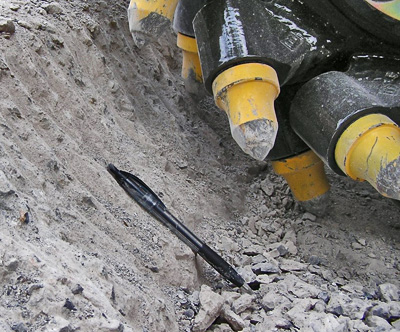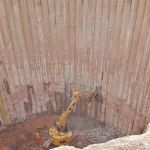Secant Walls
Fast Effective Concrete Grinding

Secant Wall Construction and Rockwheels
In secant wall construction, Rockwheels have been successfully employed during the installation of support rings and for waterproofing secants.
Rockwheel attachments are designed for quick deployment and precise grinding, allowing operators to grind out only what's needed. Because drum cutters do not compromise the adjacent wall structure, the secant wall remains strong and intact. Read more about secant walls and Rockwheels here.

Why Secant Pile Walls Are Effective
Secant pile walls use intersecting reinforced concrete piles to create a continuous wall. Primary piles and secondary piles overlap, increasing wall stiffness compared to other retaining methods. This design helps control groundwater flow while maintaining structural integrity.
Secant piles are typically installed with either steel rebar or steel beams, adding strength for deep excavation projects. In difficult ground conditions, accurately located piles provide sufficient strength to support surrounding structures and prevent soil movement.
Rockwheels in Secant Pile Wall Construction
Rockwheels provide precise cutting for secant pile walls, ensuring clean removal without damaging adjacent piles. Their efficient design helps maintain pile overlap, which is essential for structural integrity.
Key benefits of Rockwheels:
- Precision cutting – Removes only necessary material while keeping adjacent piles intact.
- Low vibration – Ideal for use near surrounding structures and in areas with noisy construction restrictions.
- Adaptable to various excavators – Available in multiple sizes to fit different job requirements.
- Improved construction alignment – Helps maintain consistent pile overlap and deep pile placement.
The Rockwheel G60, for example, operates at 45–65 RPM with 47,316 ft/lbs of torque, making it effective for deep piles and difficult ground conditions. With advanced cutting technology, Rockwheels enhance both efficiency and safety in secant pile wall construction.
Secant Pile Walls vs. Tangent Pile Walls
Secant pile walls and tangent pile walls both provide excavation support, but their construction and performance differ.
Secant pile walls
- Construction: Built with overlapping primary piles and secondary piles, typically overlapping 75–150 mm (3–6 inches) to create a continuous wall.
- Groundwater control: The overlap makes secant walls water-resistant, ideal for high-water-table areas and projects requiring waterproofing.
- Reinforcement: Typically includes steel rebar or steel beams for added strength in deep excavations and challenging soil conditions.
- Applications: Used in urban environments, deep excavations, and projects needing high stiffness or water tightness.
Tangent pile walls
- Construction: Made of closely spaced adjacent piles that touch but do not overlap.
- Waterproofing: Less effective at controlling groundwater flow since there is no pile overlap.
- Reinforcement: Often includes steel bars or steel beams for structural stability.
- Applications: Suitable for earth retention in areas with stable soil conditions or where cost efficiency is a priority.
Secant walls offer better groundwater control and increased stiffness, while tangent walls are a more economical choice for projects where waterproofing isn’t needed.
Construction Considerations for Secant Piles
Secant pile walls, along with soldier pile walls and sheet pile walls, play a critical role in excavation and retaining structures. Their construction requires precision to maintain stability and prevent groundwater infiltration.
Key factors in secant pile wall construction:
- Accurate pile placement – Secant piles are installed using auger cast methods to maintain proper pile overlap and wall integrity.
- Guide walls – Used to keep piles constructed flush, improving alignment and gaining sufficient strength.
- Groundwater control – Properly constructed secant walls prevent seepage, making them ideal for deep excavations.
- Structural stability – Reinforcement with structural concrete and steel rebar increases durability, especially in challenging soil conditions.
Improving Structural Integrity with Guide Walls
Guide walls play a crucial role in constructing secant pile walls, keeping primary piles and secondary piles accurately aligned. This precision prevents shifting during excavation and helps maintain pile overlap, which is essential for stability.
Key benefits of guide walls:
- Improved alignment – Keeps piles properly positioned, reducing construction errors.
- Increased construction alignment flexibility – Ensures secant walls are built correctly, even in challenging conditions.
- Structural strength – Helps secant piles and tangent piles gain sufficient strength to withstand pressure from surrounding soil.
Final Thoughts
Secant pile walls are the go-to choice for projects that need strength, stability, and groundwater control. They handle tough soil conditions and deep excavations better than tangent pile walls or sheet piles, offering increased construction alignment flexibility and long-term reliability.
Getting it right means using guide walls, precise pile placement, and the right tools. That’s where Rockwheels from RockZone Americas come in.
Their precision cutting keeps pile overlap intact without damaging adjacent piles, making construction faster and more efficient. With the right approach, secant walls hold strong, and projects move forward without costly delays.



